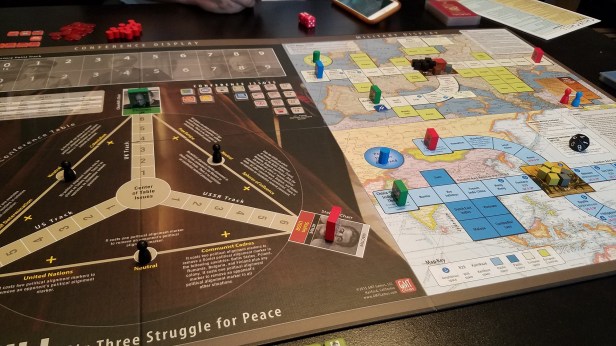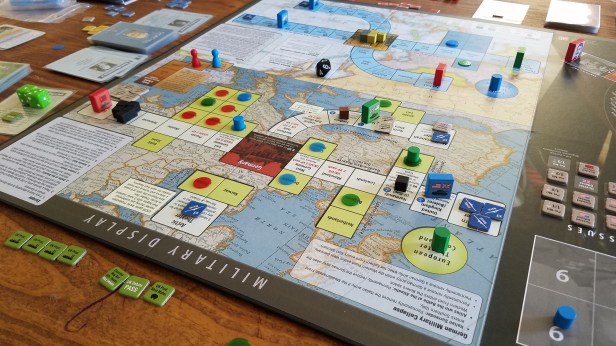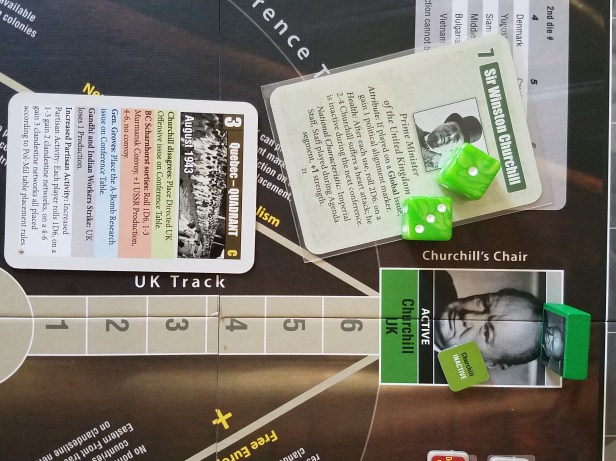I picked up Churchill back in 2014 when it first was printed, but I got it from a third party seller, not being initiated yet into the whole GMT P500 system. From what I could tell, it wasn’t getting a lot of buzz amongst board gamers on BGG and there was only 2 YouTube videos about the game where I could learn a little more (One from Mark Herman and his wife, the other from Stuka Joe). I realize now that I was wrong to a large extent about the presumptive popularity of the game. Firstly, I had it whilst it was brand new so the buzz was just getting started in a major way. Secondly, Churchill is viewed by many as a wargame and as such many euro gameres are hesitant to give it the try it so rightly deserves.

Previous to me buying Churchill the only other GMT game I had played was Labyrinth and of course the infamous Twilight Struggle. When Grant and I set it up I had poured over the rules and we were intrigued to see what the game would provide for us. I remember the thing that most interested me was the conference table. I love head to head interactions in a game and this was a new take on a CDG that allowed for 3 players and some extremely tough decision making.
Mechanics
What initially drew me to Churchill, as I said, was the conference table/negotiation aspect of the game. If there’s one thing you need to know about me from a gaming perspective it’s that I love player interaction and bluffing. The idea of the Big Three carving up the world and arguing over policies that would affect the world for generations to come was too tantalizing to pass up.

Each player chooses one of the 3 available factions to play including the United States of America led by President Franklin Delano Roosevelt, England led by Prime Minister Winston Churchill and the Soviet Union led by the dictator Joseph Stalin. If you don’t have enough players there are bots (a seemingly intelligent, albeit gamey AI) that you can use in place of a player. It’s basically a flow chart of priorities to guide you in what they do, or should be doing based in history. For the best possible experience you definitely want three live, human players. Each player has a leader for their faction that acts as a sort of trump card during the debates and a deck of Staff Cards. The Staff Cards are real politicians, aides, military leaders and lobbyists that all had their own motivations, personalities and agendas who were present during at least one of the conferences historically speaking.

Over the course of 3-10 Conferences (depending on game length selected) players use those cards to move issue chits along the tracks toward their own seat. This represents their winning the argument and being able to enforce those issues, or alter the game in some other way.
The board sets up with the war already a few years into it’s progress. Players take turns in initiative order choosing two issues to place in the center of the table; already there’s decisions about what you need, versus what others need. Will you try to petition other factions to give you their resources, or try to coerce the Russians into invading Japan early? Then you spend the Debate phase playing all of your staff cards to try and move those issues so you dictate how they play out on the abstracted military board.

I cannot express just how tight the debating, and counter debating is. It’s so tense, just as the real conferences were. Churchill was fully deserving of the awards that it won because it is both unique, deep, and rewarding on a whole other level. Seriously, it lived up to, and exceed all my expectations.
After the negotiations are over the players then enact the issues that they won, using them to allocate resources to advance the war fronts, affect political and clandestine powers in newly liberated countries, and alter the balance of power in manifold other ways.
Scope
When I first bought the game I thought it was a WWII war game, from a fascinating and different perspective. But having played it now a number of times I find myself reevaluating that analysis.

Churchill’s subtitle is ‘Big Three Struggle for Peace’. I Initially thought that was about finding a definitive end to the world wide conflict and stamping out the Axis powers. But that too was wrong. This is a game where you mostly won’t have a problem defeating the Axis powers, eventually you’ll build up forces strong enough to take them out almost every time. That’s not a bad thing, you just have to think of this game as something other than a strategic level wargame, because it isn’t. Churchill is about the struggle for the peace that followed the war. Winning the peace is more valuable than winning the war, so they say.
In that way this game is more of a precursor to the Cold War, which is where this game leaves off but it very much feels at times the same way that Twilight Struggle feels. By that I mean, you will smile at those you call friends and curse them under the (literal) table. You will find yourself cutting deals with the Russians in order to swing resources away from the Americans, or allowing the British to have political influence in the Middle East in order to keep the Russians out. I’m a huge fan of this kind of wheeling and dealing, and it is thrilling and also terrifying to do it on this scale. You will sit in Roosevelt’s shoes at the bargaining table and reenact how this actually happened in real life. A sobering thought at times, and many lessons and parallels to be drawn in modern times also.

Is this game for me?
Emphatically yes. That might seem like it’s a sweeping statement, but that’s because it is. For me, this is NOT a war game, it’s a deep card game that has specific and meaningful ramifications. You’ll be playing your own hand, the board, and the other players at the table all at the same time. There’s no reason to be scared of this game in the same way a non-wargamer might be of something like Empire of the Sun. This game, whilst more complex than most euro-games, is also quite accessible. There isn’t a million counters on the board, and you play the game in distinct and organized logical phases so you’re not overwhelmed. I think this game could, and should be played by almost every gamer, in the same way that Twilight Struggle is played regularly by many who would shy away from a game like Combat Commander.

The other great thing about this game is that you don’t need to know all that much history to enjoy it. The victory conditions are clear, if manifold, and there’s play advice in the rulebook for new players to build strategies towards. I would even say that this game is a great way to learn some history!
For those with a heavy gaming pedigree this is a runaway favourite of mine, for it’s unique mechanics and rich, rewarding decision making. The game is always tense, always tight, and there is always a way ‘back-in’ if you lag behind, you just have to think outside the box at times. I’m looking forward to the next game in the series Pericles, which is a four player game with two ‘teams’ much like the COIN games, where two factions have similar, but not the same goals. Watch out for that one coming soon from GMT! Also, if you are interested we have played multiple games and tend to do what we call Action Points, which are an entry where we create a fake headline using an online generator for flavor and to highlight aspects of the games and its rules to introduce new players to the system. Here are several of our posts for your enjoyment: Action Point 1, Action Point 2, Action Point 3, Action Point 4 and Action Point 5.
-Alexander


Great review? Mow I just need my p500 version to show up!
LikeLiked by 1 person
Woops. Ignore the question mark!
LikeLike
In our gaming group’s experience, it’s not as easy as you asset to take out all of the Axis powers before the game ends. The players must somehow concentrate their efforts to beat the Axis while advancing their own interests to win the game. This tension is nail-bitingly wonderful. Some don’t care for the victory conditions, but they don’t bother me at all. They are entirely consistent with the theme of the game, and the game is a blast even if you lose…
LikeLiked by 1 person
Interesting that your group feels that way, maybe that’s just something we focus on slightly differently. We always find ourselves in a race to get to Germany which brings it’s own head to head tension.
I fully agree with the victory conditions, though. I can get hammered in this game and I couldn’t care less because I always have a blast just playing this one. Which is the sign of a truly great game to me.
LikeLike
Novice players need to beware of getting so involved in the conference part that the war actually languishes, particularly in the training scenario. Another novice move to beware of is reflexively grabbing every point you can only to find you’ve gotten too far ahead of the other players to “recover.” The rules already caution against this but ingrained habits die hard.
LikeLiked by 1 person